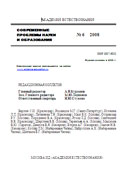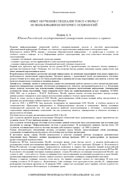PDF-версия статьи


|
According to the current regulatory documentation the insulation control is carried out in two categories ET-1 and ET-2 [1].
The EI-1-testing is stationary and implemented by immersing made hank into the water. Immersed cable is kept in water for a determinated time at a high test voltage. For this method of control it is extended release cycle of the product and it need wide additional areas of the cable manufactured company [2]. Another significant disadvantage of the water test is the fact that this category of cable control is carried out in the final stage of the process, so the detected defects lead to expensive cost of the enterprise.
In comparison with ET-1, ET- 2-testing has several advantages: small size, no need the aquatic environment during the tests. The most important advantage is the fact that this control is in-process. These make possible to correct the technological mode on time and prevent the emergence of mass marriage [2]. The disadvantages of this testing are low sensitivity in comparison with stationary water tests.
Another type of in-process insulation control is control of the electrical capacitance of the cable area. This type of control is carried out by linear capacitance measuring equipment while the controlled insulation is under water (water cooling bath). The quality of insulation is possessed by deviation of the capacitance. This method have high sensitivity (except defects with small dimensions, such as crack, cutting) but a significant disadvantages is necessity an water (as in the ET-1-testing), and a higher cost of the device (in comparison with category EI-2 testers).
Considering the disadvantages of the existing control methods, it is offered the new method - cable capacity control in high voltage insulation test.
Undoubted advantages of this method are:
1) an increase in sensitivity to defects due to the functional combination of the two control methods;
2) serviceability, no need for frequent system maintenance (in comparison with linear capacity measurement device).
3) low cost of the device due to the existence of the necessary assemblies (for the development of the device it is necessary to change the software of the high-voltage test).
Thus, the proposed method combine the two in-process methods of control. It will make this device not only cost-effective solution, but also will increase the efficiency of the control noticeably.
Literature:
1. Cables, wires and cords. Methods of test voltage: GOST 2990-78. - Ed. June. 1986 as amended. 1, 2, 3 (ISC 11-81, 10-84, 10-86). - Instead of GOST 2990-72, GOST 17397-72; introduced. 20.12.78.
2. Steblevskaya L.A. , Chernevskii I.N. Study of the efficacy trials insulated conductors and wiring devices continuous monitoring // Proceedings of the All-Union Scientific Research of Design and Technological Institute of the cable industry. - Moscow, 1974 - C. 217-232.
ОПУБЛИКОВАНО
Starikova N.S. Cable insulation control. // Современные проблемы науки и образования - 2015.-№6. (приложение "Технические науки"). - C. 5